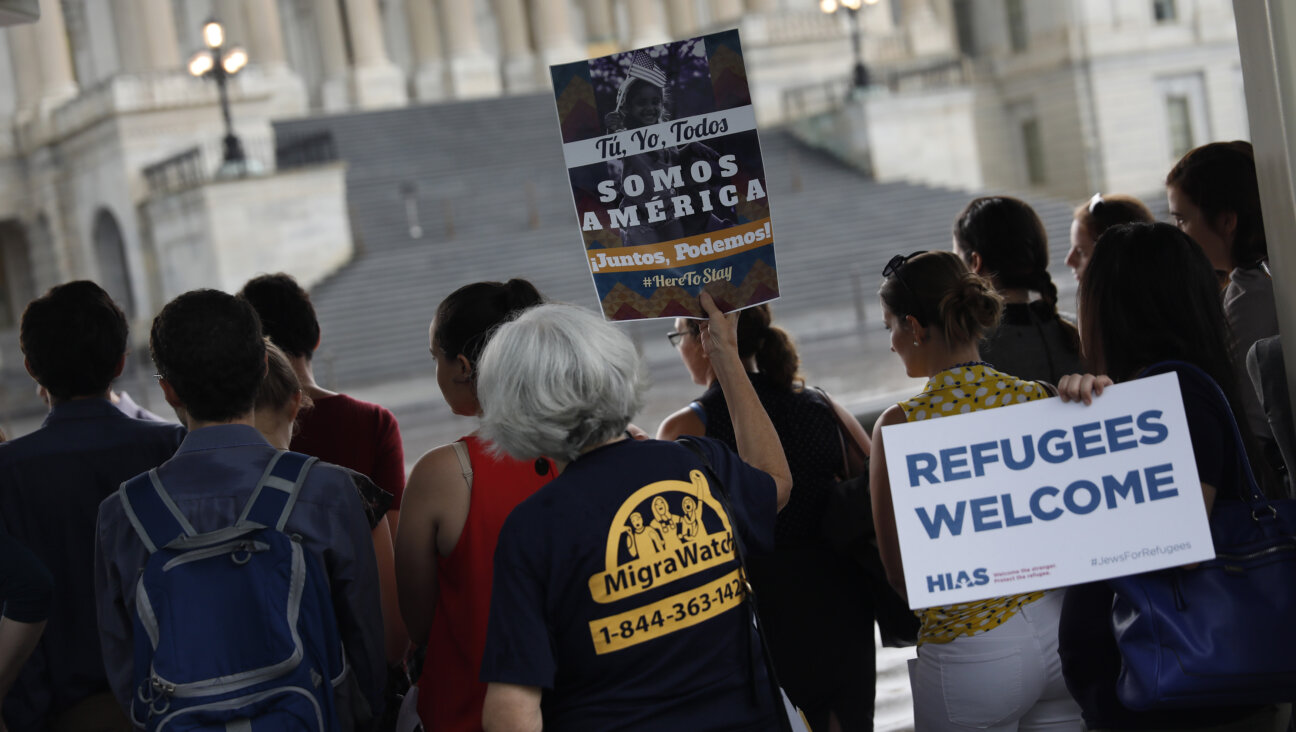What Course Will ADL Chart Without Abe Foxman?

Image by Getty Images

Image by Getty Images
In an age of canned, anodyne statements from public figures reticent to say what they really think, Foxman offers an authentic, unabashed voice free of artifice, hesitation or restraint.
Foxman also has something else when he speaks: listeners. Though the ADL doesn’t represent anyone but itself and Foxman is not an elected official, he is widely seen by journalists, the public and especially the White House as representing American Jewish opinion – to the consternation of many community activists to Foxman’s right and left.
“Abe is one of the three or four people you have to speak to on any given issue,” said former White House official Jarrod Bernstein, who did Jewish outreach during President Barack Obama’s first term.
“Abe was like an uncle to me. If you did something he thought you were on the wrong side of, he was going to let you know about it,” Bernstein told JTA. “On the flip side, if he thought you were being treated unfairly, or you did something right, he wouldn’t hesitate to say that either. That’s important and we need more of that in the American Jewish community.”
Foxman, who has run the ADL as national director since 1987 and worked there since graduating from law school in 1965, will be succeeded next month by Jonathan Greenblatt, a White House aide and social entrepreneur.
Under Foxman’s leadership, the ADL has become a $60 million-a-year juggernaut that runs anti-bias educational and training programs, monitors anti-Semitism in the United States and around the world, advocates for anti-discrimination legislation, and maintains regional offices around the country to discharge these functions. It has also served as a bully pulpit for Foxman, who managed to become the world’s chief arbiter of what qualifies as anti-Semitism — and the granter of absolution when warranted.
“He has an uncanny sense to know what to get involved with,” said Myrna Shinbaum, who worked at the ADL for 20 years and served as Foxman’s director of media relations and public information.
The case of fashion designer John Galliano represents a classic case of Foxman’s capacity to censure and forgive. When Galliano was caught on video in February 2011 going on a drunken, anti-Semitic tirade, the ADL helped lead the charge that resulted in Galliano’s firing by Christian Dior. But once Galliano made amends, Foxman was just as vociferous in defending Galliano and vouching for his rehabilitation.
In 2013, after Galliano had gone through counseling and was making his return to the design world, the New York Post accused Galliano of dressing in Hasidic garb and thereby mocking Jews. Foxman immediately jumped to Galliano’s defense, calling the story “a deliberate, malicious distortion” of Galliano’s outfit and intent.
“For the past year and a half, Mr. Galliano has been on a pilgrimage to learn from and grow from his mistakes. Now people are trying to distort and destroy him,” Foxman said in a statement. “He has spent hours with me and with others in the European Jewish community, including rabbis and Holocaust scholars, in an effort to better understand himself and to learn from his past mistakes. He is trying very hard to atone.”
Kenneth Jacobson, the ADL’s deputy national director, said this is one of Foxman’s signature moves: The ability to turn someone who had crossed the anti-Semitism line into a friend of the Jews.
After a high-profile Christian evangelist, the Rev. Bailey Smith, said in 1980 that God does not hear the prayers of Jews, the ADL blasted him. But then Foxman, who at the time was ADL’s associate national director and director of international affairs, orchestrated a visit to Israel for Smith. By the end, ADL officials said, Smith was calling him Rabbi Foxman.
“He’s able to take a very negative situation and turn it into a very positive one,” Jacobson said.
Along the way, Foxman has also become a confidant of presidents, prime ministers and too many celebrities to count.
But on the central question of ADL’s raison d’etre — fighting anti-Semitism — did Foxman make any difference?
It’s not hard to find anti-Semitism around the world today. In Europe, it’s evident in deadly attacks, anti-Israel demonstrations and boycott efforts.
In Venezuela, Turkey and elsewhere, it comes from the mouths of public officials. On the Internet, it takes the form of virulent expressions of hate. In the Arab world, Jews are caricatured as they used to be in Nazi newspapers.
By the same token, anti-Semitism in the United States is at historic lows. The Jews in Israel live in relative safety. In Russia, Ukraine and elsewhere in Europe, governments are protective of their Jewish populations.
It’s hard to connect any of this to the ADL’s work, for better or for worse — though Foxman says the ADL is part of the reason America is one of the least anti-Semitic countries in the world.
“I don’t take credit for it, but I’m part of the effort — not only of the American Jewish community, but of decent people in this country, to fight it,” Foxman said.
“The most significant difference between the United States and the rest of the world is that in this country, there is a consequence to being a bigot and an anti-Semite. If you’re in commerce, if you’re in politics, if you’re in the arts — whatever it is — and you act out as an anti-Semite, you will pay a price.”
Foxman’s personal story has lent moral authority to his work. Born in 1940 in Poland, Foxman’s Jewish parents left him in the care of his Polish-Catholic nanny during the war in a bid to save his life. Raised as a Catholic, Foxman didn’t discover he was Jewish until after the war, when his parents came to claim him. His nanny refused to give him up, resulting in a custody battle.
After Foxman’s parents eventually won, they took their son with them to America, and only gradually did he let go of his Catholic habits and embrace his parents’ religion.
“I’m a product of the worst in humankind and the best in humankind,” Foxman told JTA.
Foxman said he ended up at the ADL more by chance than design. He did some freelance translating for the organization — then known as the Anti-Defamation League of B’nai B’rith — while in high school at the Yeshivah of Flatbush in Brooklyn, and followed reporting on the ADL in the Jewish press.
Foxman planned to be an engineer, largely so he could help Israel or America in the age of Sputnik, he said, but he changed his mind after suffering through two years of chemical engineering at City College. He switched to political science, attended New York University law school and reached out to the ADL’s general counsel, Arnold Forster, when he was interviewing for jobs. Foxman was offered a position on the spot.
“To what extent did my experiences in the Shoah, the D.P. camps, my Catholicism have to do with that, I don’t know,” Foxman said. “I have been very lucky. To get up every morning and to have an opportunity to try to make a difference in both fighting hate and building love — wow. I have been very privileged.”
A message from our Publisher & CEO Rachel Fishman Feddersen

I hope you appreciated this article. Before you go, I’d like to ask you to please support the Forward’s award-winning, nonprofit journalism so that we can be prepared for whatever news 2025 brings.
At a time when other newsrooms are closing or cutting back, the Forward has removed its paywall and invested additional resources to report on the ground from Israel and around the U.S. on the impact of the war, rising antisemitism and polarized discourse.
Readers like you make it all possible. Support our work by becoming a Forward Member and connect with our journalism and your community.
— Rachel Fishman Feddersen, Publisher and CEO























